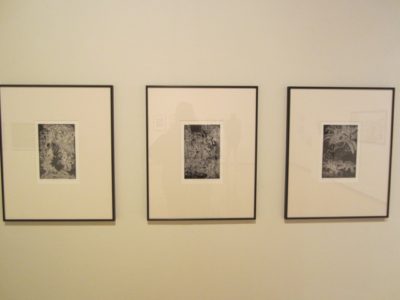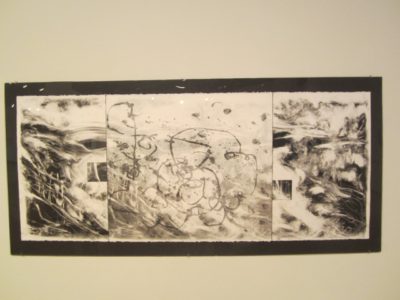GUIDELINES FOR MATTING AND FRAMING:
The professional presentation of traditional 2D prints should follow museum standards: All materials should be acid free and archival (reversible.)

Traditional window mat with metal section framing: Susan Naylor, NKU “In Your Dreams” NKU main gallery show 2013

Large print, mounted on a backing mat and hung under glass and L brackets: Joline Hartig, “In Your Dreams” NKU show
MATTING:
– Avoid decorative color window mats unless they are an integral part of the work. Keep them in neutral shades – white or off-white to gray.
– Use 4-ply, archival mat board (museum quality preferred, or acid free at minimum). Window mats should have a white core, or be the same color as the mat all the way through. Do not use poster mat board that has a tan core – it is acidic and will ruin your work (and it looks cheap).
– Don’t skimp on the dimensions of the mat. Keep at least a 2 ½ to 3″ or more border all around with a ⅜ to ½ internal reveal around the print. If your print is larger, you can float the print mounted on a mat. Float bleed prints to have this same reveal if you use a window mat. (Small works need larger mats to present well. Skimpy mats can make the work look amateurish. Spend your money on the matting and not the framing if you have to make a choice.)
– Hinge the print to the mat at the top only. Use archival tape or mulberry paper hinges and acid free glue, or wheat paste (museum standard). It needs to be reversed easily.
FRAMING:
– Avoid frames that are heavier than the work (unless you are Degas or Monet!). You don’t want to upstage your print .
Consider the width of the frame in relation to the the width of the mat. It looks better if the mat is larger than the frame width so your print can breath inside it.
– In general, if you can stick to standard frame sizes and cut your mat openings so the work is centered (you do not always have to “weight” the bottom of the mat) -then you can switch out prints easily. Mat board and foam core come in 32 x 40” size, so you can plan print and frame sizes to be able to take advantage of that.
– One way to keep costs down is to use metal section frames. You can mail order them from American Frame, or others. They are also easy to disassemble and reuse.
– It is always required for you to use Plexi if you plan on having the work shipped or taken to another venue. Plexi is also better to keep fading down – using conservation plexi is the best (but it scratches).
– In general, prints should not be pressed against the glass, but I have found that during the run of a show, under hot lighting, some works on paper need to be shown that way to keep them from buckling. This will be your call. It is not a preferable method for permanent framing situations. For floated prints, use a spacer between the glass/plexi and the print.
SIGNING/NUMBERING
– Always sign your prints with name, title, edition number or other designation.
– Sign prints under the image, on the right. The edition number and title can go either under the print in the middle or left side respectively, whichever you like.
–Edition numbers are fractions with the total number of identical prints as the bottom number. Prints that are not identical should be labeled Proofs or UI – Unique Impressions – or with the additional EV, Edition Varies after the edition number.
– Always sign bleed prints the same way on the back, on the bottom of the print. You can also sign in the reveal under the print. You usually do not sign on the window mat unless there is no reveal – but this is reserved more for monotypes that are more painterly in style and matted like paintings, which they are more akin to.
HANGERS:
– FOR WORKS WITH FRAMES: USE ONLY WIRE ONLY ON THE BACK OF THE WORK with two mounted hangers on either side of the frame, ⅓ of the way down from the top of the frame.
GENERAL:
– There is an archival uv coating spray you can use to protect fragile inks. Color inks are the most vulnerable, especially if they are process colors.
– If you get yourself a vendor’s license, you can buy materials tax free and wholesale. You can save money by doing the framing yourself.
— Andrea Knarr